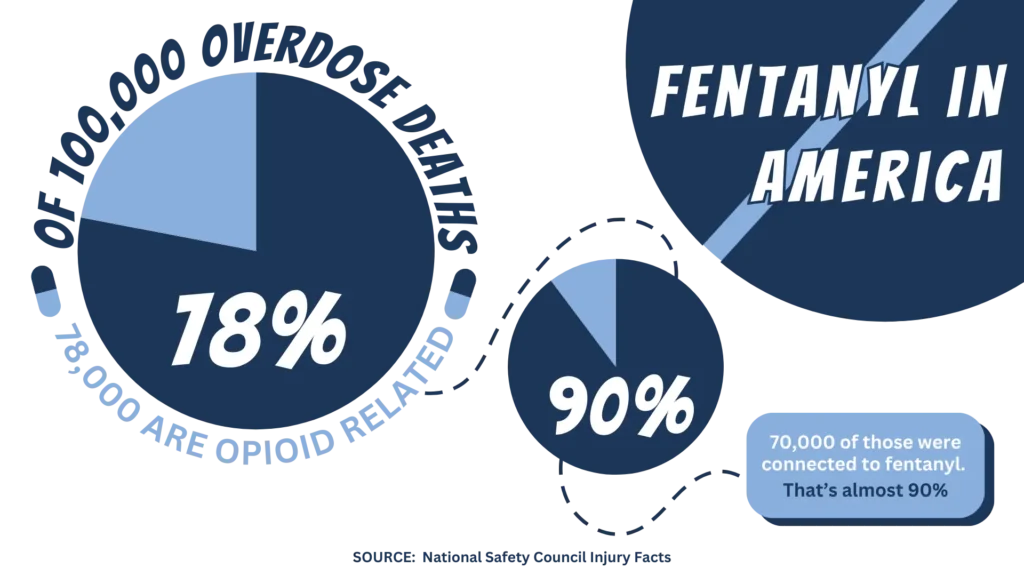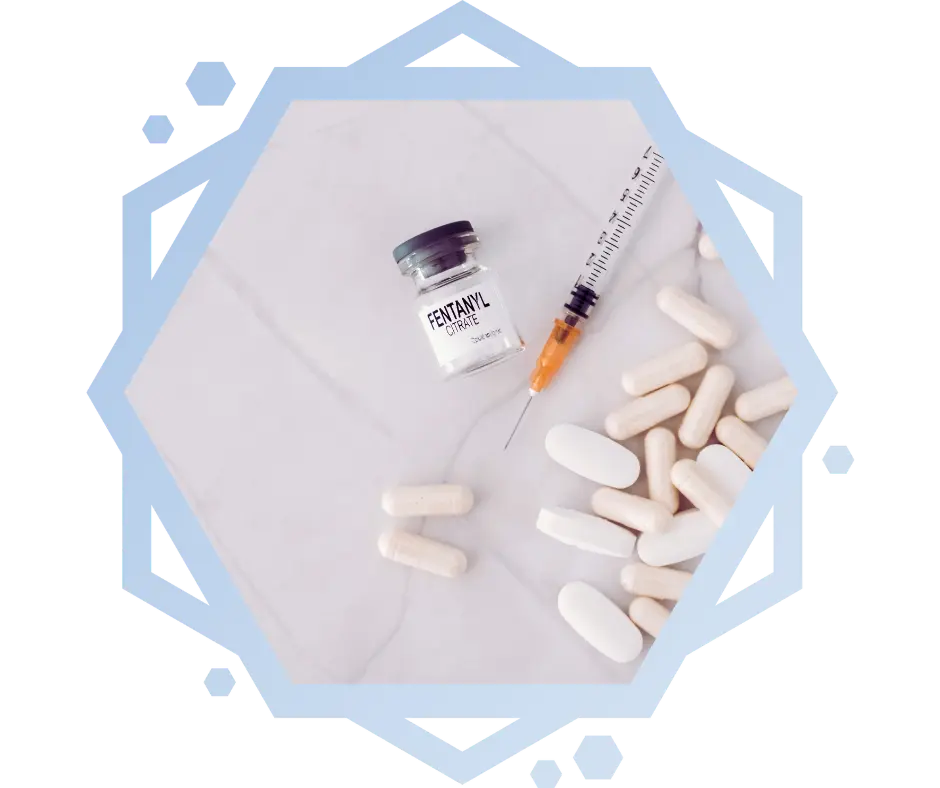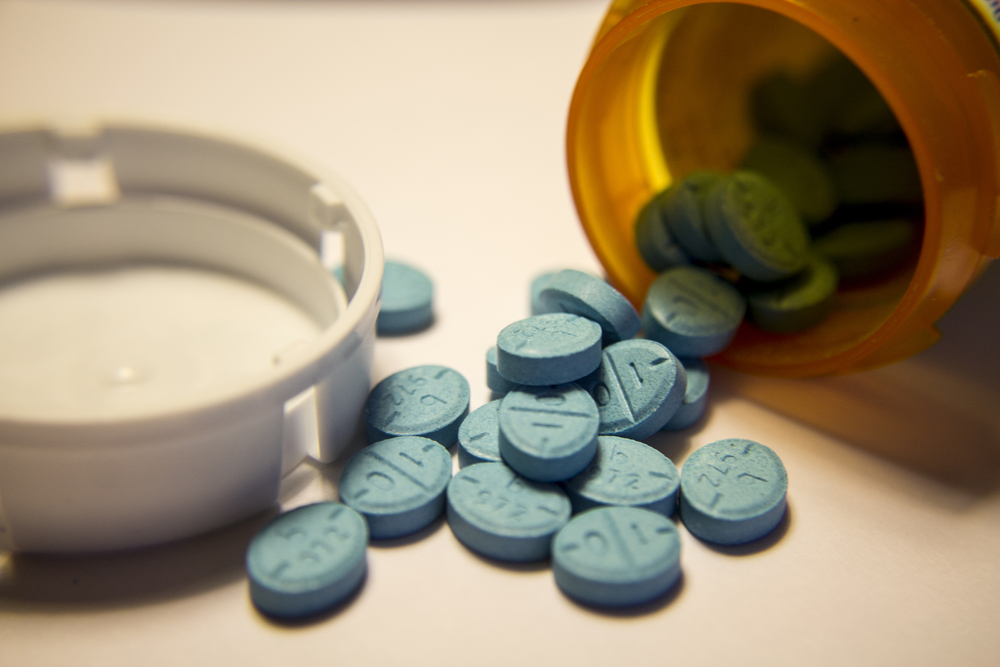Attending a fentanyl rehab can help you overcome drug addiction – if you need help with a fentanyl addiction, Southeastern Recovery Center can help you with a personalized treatment program.
Fentanyl is a powerful synthetic opioid that is similar to morphine but is 50 to 100 times more potent. Initially developed for pain management treatment of cancer patients, fentanyl is now a major factor in the opioid crisis due to its high potential for abuse and addiction. It is often prescribed in the form of patches or lozenges, but illicitly manufactured fentanyl is commonly found in street drugs, posing a significant danger to users.
Preventable drug overdose deaths rose in the United States to 99,592 in 2022. The majority of these deaths involved opioids, totaling 77,603 deaths – 70,891 of them can be traced back to the fentanyl category of opioids.
What Makes Fentanyl So Dangerous?
Fentanyl works by binding to the body’s opioid receptors, which are found in areas of the brain that control pain and emotions. Its high potency means that even a small amount can cause a significant effect, including severe respiratory depression which can be fatal. The danger is compounded by its frequent presence in other drugs, often without the user’s knowledge.

How to Recognize Fentanyl Addiction
Addiction to fentanyl can develop quickly due to its powerful effects. Signs of addiction include:
- Intense cravings for the drug
- Increased tolerance, requiring larger doses to achieve the same effect
- Withdrawal symptoms when not using the drug
- Neglect of responsibilities and interests
- Continued use despite negative consequences

The Need for Rehab for Fentanyl Addiction
Rehab for fentanyl addiction is crucial due to the drug’s potency and the severe withdrawal symptoms it causes. Detoxing from fentanyl without professional help can be dangerous and is often ineffective.
Structured rehab programs provide the medical support and therapy needed to address the physical and psychological aspects of addiction.
Finding the Right Fentanyl Rehab Near Me
When searching for fentanyl rehab near me, it is important to consider several factors to ensure you or your loved one receives the best possible care:
Accreditation and Licensing
When seeking a fentanyl rehab facility, it is essential to verify that the center is accredited and licensed. Accreditation from recognized health organizations, such as The Joint Commission or the Commission on Accreditation of Rehabilitation Facilities (CARF), ensures that the facility adheres to stringent standards of care and maintains a commitment to continuous improvement.
These accreditations are a testament to the facility’s dedication to providing high-quality treatment. Appropriate state licenses also guarantee that the rehab center meets local regulatory requirements, which is critical for ensuring safe and effective treatment.
Comprehensive Treatment Programs
A successful fentanyl rehab should offer a comprehensive treatment program that addresses all aspects of addiction. This includes a full spectrum of care:
- Detoxification: The first step in the recovery process, detox helps manage withdrawal symptoms and cleanse the body of fentanyl. A medically supervised detox ensures safety and comfort.
- Therapy: Both individual and group therapy are integral to understanding the root causes of addiction and developing coping strategies. Various therapeutic approaches, such as Cognitive Behavioral Therapy (CBT) and Dialectical Behavior Therapy (DBT), can be employed.
- Aftercare: Recovery doesn’t end after leaving the facility. Aftercare programs, including ongoing counseling, support groups, and relapse prevention strategies, are crucial for maintaining long-term sobriety. Look for rehabs that provide a seamless transition from inpatient care to outpatient support, ensuring continuous assistance and guidance.
Qualified Staff
The quality of care in a rehab facility is heavily dependent on the qualifications and expertise of its staff. It is vital to choose a facility with experienced medical professionals, including doctors, nurses, and certified addiction counselors.
The presence of psychiatrists and psychologists can also be beneficial for addressing any co-occurring mental health disorders. The compassion and competence of the staff play a significant role in the effectiveness of the treatment and the overall patient experience.
These professionals should have specialized training in addiction treatment and a deep understanding of the complexities of fentanyl addiction.
Individualized Treatment Plans
Every individual’s journey with addiction is unique, and so should be their treatment plan. A one-size-fits-all approach is often ineffective. Therefore, it is important to choose a rehab facility that offers individualized treatment plans.
These plans should be tailored to the specific needs, circumstances, and goals of each patient. Factors such as the severity of addiction, medical history, mental health conditions, and personal preferences should all be considered. Individualized plans ensure that each patient receives the most appropriate and effective care, increasing the likelihood of a successful recovery.
Support Systems
Recovery from fentanyl addiction is a long-term process that extends beyond the individual to their family and community. Effective rehab facilities recognize the importance of involving loved ones in the recovery process. Family therapy sessions help rebuild trust, improve communication, and address any familial issues that may contribute to addiction.
Support groups, such as those facilitated by Narcotics Anonymous (NA), provide a platform for sharing experiences and gaining strength from others who are on a similar journey. The presence of robust support systems is crucial for long-term recovery, helping individuals to stay motivated and connected to a network of care and encouragement.
What to Expect in a Fentanyl Rehab Program
Understanding what to expect in a fentanyl rehab program can provide clarity and alleviate some of the uncertainties associated with the process. This guide will walk you through the essential components of a comprehensive fentanyl rehab program, from the initial assessment and detoxification to therapy and aftercare. By knowing what lies ahead, you or your loved one can approach rehab with confidence and a greater sense of preparedness, ultimately paving the way for a successful recovery.
Initial Assessment
The first step in a fentanyl rehab program is a thorough assessment to create a comprehensive understanding of the patient’s condition. This multifaceted evaluation includes:
- Medical Evaluations: A complete physical examination is conducted to assess the patient’s overall health and identify any medical complications related to fentanyl use. This may include blood tests, liver function tests, and screenings for other substances.
- Psychological Assessments: Psychologists or psychiatrists evaluate the patient’s mental health to uncover any co-occurring disorders such as depression, anxiety, or PTSD. These assessments help in creating a tailored treatment plan that addresses both addiction and mental health issues.
- In-depth Interviews: Clinicians conduct detailed interviews to gather information about the patient’s drug use history, personal and family background, and any previous treatment attempts. Understanding the context of the addiction helps in designing an effective and personalized treatment strategy.
This comprehensive assessment ensures that the rehab program addresses all facets of the patient’s health, providing a solid foundation for recovery.
Detoxification
Detoxification is the critical process of allowing the body to eliminate fentanyl and other toxins. Given fentanyl’s potency, this phase is often challenging and requires medical supervision to manage severe withdrawal symptoms, which can include:
- Severe Anxiety and Agitation: Patients may experience intense nervousness and restlessness.
- Muscle Aches and Pains: Physical discomfort and pain are common as the body adjusts to the absence of fentanyl.
- Insomnia: Difficulty sleeping is a frequent withdrawal symptom.
- Sweating and Chills: Patients may alternate between excessive sweating and feeling very cold.
- Nausea and Vomiting: Gastrointestinal distress is a typical symptom during detox.
Medical professionals may administer medications such as clonidine, anti-nausea drugs, or buprenorphine to ease these symptoms and ensure patient safety and comfort during detox.
The detoxification phase is crucial because it prepares the body for further therapeutic work in rehab.
Inpatient vs. Outpatient Rehab
Choosing between inpatient and outpatient rehab depends on the severity of the addiction and the patient’s personal circumstances:
- Inpatient Rehab: This option provides a structured, immersive environment with 24/7 medical care and supervision. It is ideal for individuals with severe addictions or co-occurring mental health disorders. Inpatient programs typically last from 30 to 90 days, offering intensive treatment and a distraction-free environment to focus entirely on recovery.
- Outpatient Rehab: Outpatient programs offer more flexibility, allowing patients to live at home and attend treatment sessions at scheduled times. This is suitable for individuals with milder addictions or those who have completed an inpatient program and need continued support. Outpatient rehab enables patients to maintain daily responsibilities such as work or family commitments while receiving treatment.
Both options have their benefits, and the choice depends on the specific needs and circumstances of the patient.

Therapy and Counseling
Therapy is a core component of fentanyl rehab, addressing the psychological aspects of addiction. Common therapeutic approaches include:
- Cognitive Behavioral Therapy (CBT): CBT helps patients identify and change negative thought patterns and behaviors associated with their addiction. It equips them with coping strategies to handle triggers and stressors.
- Dialectical Behavior Therapy (DBT): DBT focuses on teaching skills to manage stress, regulate emotions, and improve relationships. It is particularly effective for individuals with co-occurring mental health disorders.
- Group Therapy: In group therapy sessions, patients share their experiences and learn from others facing similar challenges. This supportive environment fosters a sense of community and mutual encouragement.
- Family Therapy: Involving family members in therapy sessions helps rebuild trust, improve communication, and address any familial issues that may contribute to the addiction. Family support is crucial for long-term recovery.
Medication-Assisted Treatment (MAT)
MAT is an effective component of fentanyl rehab, combining medications with behavioral therapies. Medications used in MAT include:
- Buprenorphine: Helps reduce cravings and withdrawal symptoms.
- Methadone: Another medication that can reduce withdrawal symptoms and cravings.
- Naltrexone: Blocks the euphoric effects of opioids, helping to prevent relapse.
MAT is often integrated with behavioral therapies to provide a holistic approach to treatment, addressing both the physical and psychological aspects of addiction.
Aftercare and Relapse Prevention
Recovery is an ongoing process that continues long after rehab. Aftercare programs are essential for maintaining sobriety and preventing relapse. These may include:
- Ongoing Therapy: Continued individual or group therapy sessions help address any emerging issues and provide continuous support.
- Support Groups: Participation in groups like Narcotics Anonymous (NA) offers ongoing peer support and encouragement. These groups provide a sense of community and shared experience.
- Sober Living Homes: Transitional living environments offer support and structure for individuals re-entering society. These homes provide a drug-free environment with peer support and accountability.
Aftercare programs are crucial for sustaining recovery and helping individuals navigate the challenges of maintaining sobriety in their daily lives.
Fentanyl Rehab Can Help You Overcome Addiction
Seeking help for fentanyl addiction is a major step towards recovery. With the right support and treatment, individuals can overcome their addiction and lead fulfilling lives. Southeastern Recovery Center understands that each person needs individualized treatment programs – and our experienced staff is ready to help.
If you or a loved one is struggling with fentanyl addiction, don’t hesitate to reach out to Southeastern Recovery Center. The path to recovery is challenging, but with professional help, it is possible to regain control and build a healthier future.





